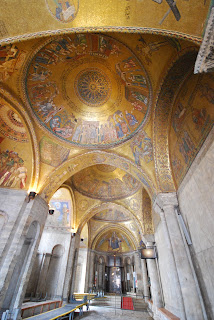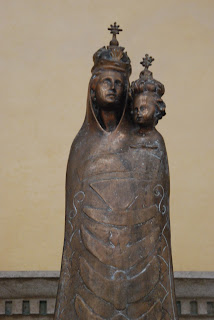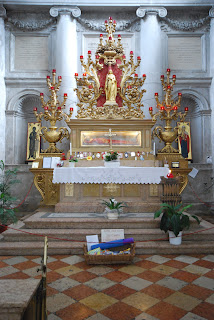Our first full day in Venice had a few simple goals: see the big, touristy things that you just can't go to Venice and not see, tack on a few churches here and there and otherwise simply walk through as much of the city north of the Canal Grande as possible. The big touristy things that define Venice are the Rialto Bridge, San Marco square and the Basilica and the Doge's Palace. We mapped out a route that would take us to or past all three and set out.
When you do things like this it takes a certain amount of focus, as you need to make sure that you can fit it all in during one day. However, you have to be open to the little side attractions that can help add to your appreciation of a place. On the way to the Rialto Bridge we got a heady smell of fresh fish and followed it around a corner to find a fish market in progress. It was about 10am, so a lot of the stock had been sold but we could still wander through and get a feel for how people in Venice bought their seafood. I say seafood because it was certainly more than fish, although the small, complete shark they had on display was most impressive. They had lots of squid, octopus and cuttlefish, which you saw on lots of menus. Shellfish were also there in abundance, with the shopkeepers struggling sometimes to keep the snails in their display case. The most abundant fish was sole, which seems to be somewhat of a staple for Venetians. Around the corner from the fish market was a fruit and vegetable market that had a wonderful assortment of both. Along with the standard cherries, peaches and nectarines, they also carried an abundance of zucchini flowers. It was a cool experience.
The Rialto Bridge is better observed from a gondola on the canal below than from the crowded footpath between the shops on top. If I had to put it head to head against the Ponte Vecchio in Florence, I think it would come up short. It did provide us the means to cross the canal and make it into the Piazza San Marco, where the enormous space between the water, the Doge's Palace, the Basilica and the clocktowers was just crawling with people. San Marco attendants worked their way through the crowds, making sure the rules against sitting and eating were being followed. We marvelled at the old clock tower first, which has a face that still shows the sun going around the earth. The blue that they incorporated really makes it stand out. The other large tower is much more imposing, but significantly plainer. Made of brick with marble embellishments, it is the tallest thing in Venice. The humidity based haze that we had during the day led us to decide that climbing the 200 plus steps to the viewing platform would not likely pay off, so no panorama views of the city are included in Fiona's shots. We did get in line for the Basilica, which must have been several hundred people long. But it moved so quickly that within 15 minutes we were inside. I think it must have taken another 15 minutes to pick our jaws off the floor. The view was almost indescribable, which is a bad thing for someone trying to blog about it. The ceiling of the entire cathedral was awash in gold mosaic. From the large open spaces in the domes and apses to the undersides of internal arches, everything was covered in the precious metal, inlaid with the requisite religious scenes, of course. The floors, if anyone bothered to look down, had marble mosaics of animals and other designs that were just as impressive. The Basilica is a definite must-see if you are in Venice. The outside mosaics are a nice taster, but the full meal deal is definitely the inside. It really is hard to imagine that for the longest time, this was just the Doge's private church. It wasn't made the city's basilica until the 1800's. Not bad for some rich guy, elected by his peers to a lifelong position that doesn't really ask him to do anything or give him the power to make any decisions.
After that we sort of expected the Palazzo Ducale to be equally opulent, and at one time it may have been, but it was a touch disappointing in its current state. Sure the outside is a rich tapestry of marble, all linked in intricate designs, but the inside has seen better days. Some things are still duly impressive, like the aptly named Golden Staircase and some of the great halls used to house the assemblies of nobles that governed the Republic. There were lots of religious paintings hung everywhere, a favourite theme being the royal whupping the Venetians laid on the Turks at the Battle of Lepanto. I think we liked going through the building, but it was hot and humid and, ironically enough, the only place we really found relief was in the prisons deep inside the palace. We spent more time wandering through there than anywhere else, marvelling at the old locks and cells. Unlike most of the people who originally inhabited them, we eventually did see the light of day again.
We left the Square to the rest of the tourists and wound our way back through the city, across bridges and canals in search of the church of San Giovanni e Paolo, a large plain looking Gothic church we saw during our initial boat tour. We were advised to ignore the plain looking exterior and to go see the inside, and this is advice best followed for anyone in Venice. While it didn't have the jaw-dropping ceiling mosaics of the San Marco, it did have a whole series of dedications to some of the locally famous people buried inside, which includes at least two dozen Doges. There was spectacular sculpture, including this floor to ceiling piece that had a piece of marble carved to look like a giant curtain. There were others as well, but I think our favourite was the beadwork throne and canopy. It was a stunning piece of craftsmanship. There was also a preserved but decaying foot from St. Cathering of Sienna in a reliquary. I suggest you don't view this around lunch time. Other than that, we highly recommend a visit to it if you are in the neighbourhood.
We spent the rest of the afternoon wandering around the northern section of the city, stopping to look inside everything and anything of interest. Most of the churches are the same, rather grand looking, if not a little run-down from the outside, but plain inside, with one or two pieces of significance. We did stop and light a candle at the church of San Geremia, where the preserved body of San Lucia lies in state. She's the patron saint of eye diseases and we have a few people important to us that could use her assistance and attention.
So over 18,000 steps later we were back at the hotel, putting our feet up and relaxing a little before dinner. Without the energy or wherewithal to look up a good dinner spot, we took up the recommendation of the concierge and stopped at a local place where it appeared that the vaporetto drivers like to visit. This was a mistake. If we're feeling charitable we could say that they were distracted by a big group of German tourists who had staked out a corner of the restaurant, but that doesn't seem fair to us. The service was slow and poor, the food was not what it should have been, especially considering the extra money we shelled out for our lobster tagliatelle - I think our poor lobster must have died of starvation. When we finally did manage to get someone's attention, we paid our bill and left. I guess they can't all be winners.
The one negative still left us on the positive side of the ledger in terms of overall experience, however, and we hit the hay tired but looking forward to another day of exploring.








































No comments:
Post a Comment